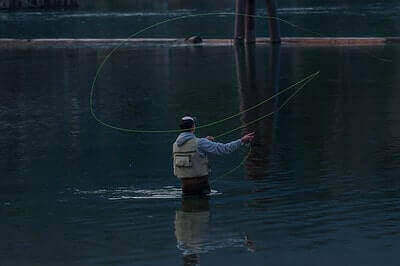Disclosure: We may earn commissions if you purchase products after clicking on a link from our site.
Do you want to be more successful with fly fishing? Would you like to catch more fish? Not only the thrill of the catch but also knowing that you have mastered the techniques of fly fishing can be satisfying. In this article, we share fly fishing tips to help you be more successful with fly fishing.
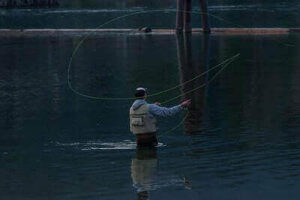
Table of Contents
Fly Fishing Tips
1. Walk Gently & Quietly
It is often overlooked but doesn’t approach the bank of the water walking as you do every day. Many fish love to hang around the banks of the lakes and ponds. They will feel the vibration from your movement and get spooked. Don’t drop any bag onto the ground as the impact will also be felt by the fish. Move gently and quietly as much as you can. If you want to learn how to fish a pond, click on this link.
2. Static Fishing Trick
There are times when no matter what you do, you won’t get a bite. This usually happens when the temperature is really warm or cold. In this scenario, you can go static with your flies. Sometimes this trick is what works and you finally get a bite.
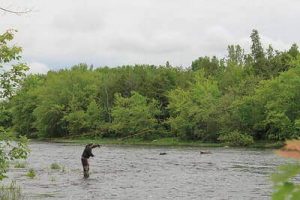
3. Leader Knots
Monitor your leader regularly for wind knots. These wind knots are the result of tailing loops when you cast. They can minimize the strength of your line even though they seem insignificant. If your line has wind knots, you will need to change your line or lose any fish you get.
4. Sharp Hooks
You need sharp hooks. Don’t keep fishing with your hooks when they get dull. This will cause you to lose fish. Get a hook sharpener and check your hooks regularly. When they become dull, sharpen them.
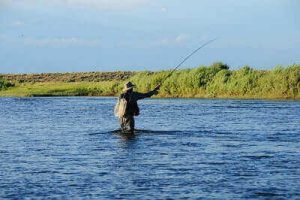
5. Don’t Fish Dry
It is not a good practice to leave the dries in the same place for a long time. Instead, cast out the flies, count to 10, and then re-cast to an entirely new position if they have not been taken.
6. Study The Water
Discipline yourself to study the water when you go fishing. Don’t just get to the bank and start casting. Instead, study the water currents and read the stream. When you study the water, you will figure out where the fish are most likely to be and where they are not.
7. Don’t Be Stagnant
Don’t just remain in one place for a protracted period of time. Instead, move around the water casting different sections of the water. This will increase your chances of finding the fish. Move around every 10 minutes.
Fly Fishing Line Walmart
Walmart has many fly fishing lines that you can choose from.
If you want to check the fly fishing lines at Walmart, then click this link.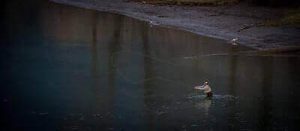
8. Experiment With Colors
To find the right color of fly to use, you will have to experiment. You can start with a dark color fly and work your way to light flies. You continue the trial and error method until you get to the bright colors and find what works.
9. Use Different Lines
Don’t just use one line all day. The floating line can be used successfully to catch fish all day. However, if the fish go deep, you will need a different line, like a weighted fly, to get to the fish.
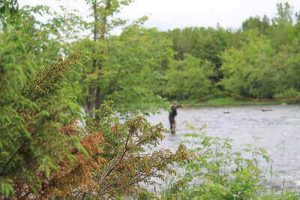
10. Polarized Sunglasses
If you noticed many anglers wear sunglasses when they fish, it’s not that they want to look cool. Instead, polarized sunglasses protect your eyes. Moreover, they enhance your vision so you can see the fish.
11. Don’t False Cast
Don’t false cast too much. False casting is when you are just going back to cast and forecast endlessly. You want to avoid it as much as possible as you can easily mess up a cast and also wear yourself out.
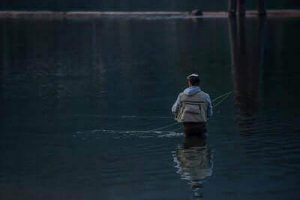
12. What Are Trout Eating
When you go fly fishing, observe the water to find out what are preys the trout are feeding on. Do you see bugs floating on the water? Look closely at the rocks, pick some up, and look for bug eggs in the dirt. Look for spider webs and see the insects they caught.
If the trout are not hitting your flies on top of the water, change it to what you observed as prey around the water. Another way to find out is to ask other anglers what they are using or stop at a local tackle shop and find out from the people there.
13. Practice Casting
This is often overlooked but you need to practice your casting. There will always be people who will play down practicing your casting, but you need to ignore them. Good casters catch more fish than poor casters. Investing time in practicing casting will be rewarding in the long run.
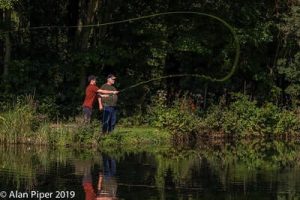
14. Fish Deeper With The Sun Up
When the sun comes out, change and fish deeper because the trout will seek deeper waters where there is less light. If you don’t go deeper, the trout will miss your flies.
15. Downscale Fly Size
If the fish are not responding to your flies, a good tactic is to scale down your fly size. If your flies are in the range of size 8, 10, or 12, scale down to 14, 16, or 18 nymph or dry.
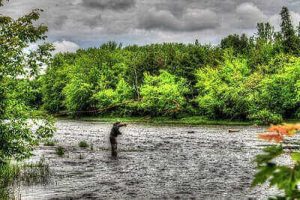
Fly Fishing Gear
Fly fishing gear is not the same as gear for traditional fishing.
1. Rods
Rods are an essential component of fly fishing gear, serving as the primary tool for casting and presenting flies to fish. Fly fishing rods are typically longer and more flexible than conventional fishing rods, designed to deliver delicate and precise presentations required for fly fishing techniques.
These rods come in various lengths and weights, each suited to specific fishing conditions and target species. For example, shorter and lighter rods are ideal for small streams and delicate presentations, while longer and heavier rods are better suited for casting larger flies or fishing in windy conditions.
Fly rods are constructed from materials like graphite, fiberglass, or bamboo, each offering different levels of sensitivity, strength, and action. Modern fly rods often feature advanced technologies and design elements to enhance casting performance and accuracy, such as faster action, improved line control, and reduced weight.
Additionally, fly rods are paired with specialized fly lines, reels, and leaders to complete the fly fishing setup, allowing anglers to effectively cast and retrieve flies while enjoying the challenges and rewards of this unique fishing technique.
2. Hip Waders
Hip waders are an essential piece of fly fishing gear, providing anglers with protection and mobility while wading in shallow waters. These waders typically extend up to the hips, offering coverage and waterproofing for the lower body without restricting movement. If you are looking for hip waders, you can read this review on the best hip waders.
Hip waders are constructed from durable and waterproof materials such as rubber, neoprene, or breathable fabrics like Gore-Tex, ensuring that anglers stay dry and comfortable throughout their fishing adventures. The adjustable waistband and suspenders allow for a customized fit, while reinforced seams and puncture-resistant materials provide durability and longevity, even in rugged fishing environments.
Hip waders are lightweight and easy to pack, making them convenient for anglers who need to traverse streams, rivers, or lakes to reach prime fishing spots. Additionally, many hip waders feature built-in gravel guards to prevent debris from entering boots, as well as pockets or attachment points for storing essential gear like flies, leaders, and tools. Overall, hip waders are indispensable for fly anglers seeking to navigate shallow waters with confidence and comfort, enhancing their fly fishing experience on the water.
3. Reels
Fly fishing reels are critical components of a fly angler’s gear arsenal, playing a vital role in controlling and managing the fly line during casting, playing fish, and retrieving line. Unlike traditional spinning or baitcasting reels, fly reels are designed to store and deploy fly line efficiently, with a focus on smooth drag systems and precise line management rather than casting distance or retrieval speed.
Fly reels come in various sizes and configurations to match different fly rod weights and fishing conditions, ranging from small, lightweight reels for freshwater trout fishing to large, powerful reels for saltwater species like tarpon or bonefish. They typically feature a large arbor design to facilitate rapid line retrieval and reduce line memory, as well as a drag system that provides consistent resistance to tire out fish without breaking the tippet.
Fly reels may have click-and-pawl or disc drag systems, each offering unique advantages depending on the target species and fishing style. Many modern fly reels are constructed from lightweight yet durable materials such as machined aluminum or carbon fiber, balancing strength and weight to withstand the rigors of fly fishing while minimizing fatigue during extended casting sessions. Overall, fly reels are indispensable tools for fly anglers, enabling precise control over fly line movement and contributing to the enjoyment and success of fly fishing pursuits.
4. Line
In fly fishing, the fishing line plays a crucial role in casting accuracy, presentation, and ultimately, landing the fish. Unlike traditional fishing methods where the weight of the lure carries the line, in fly fishing, the weight of the fly line itself is used to cast the lightweight fly.
Fly fishing lines are typically thicker and heavier than conventional fishing lines and are specially designed to carry the fly to the target area with precision. They come in various weights, ranging from delicate lines for small trout streams to heavy lines for casting large flies or in windy conditions.
The fishing line is usually attached to a leader, which is a tapered section of clear monofilament or fluorocarbon line that connects the fly line to the fly. This leader helps to transfer energy smoothly from the fly line to the fly during casting and provides a nearly invisible connection between the fly and the line, essential for fooling wary fish. The choice of fishing line depends on the type of fish being targeted, the size of the fly, and the fishing conditions, making it a critical component of fly fishing gear.
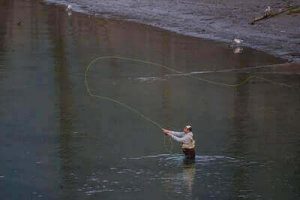
Types Of Flies
1. Wet Flies
Wet flies are a versatile category of flies used in fly fishing, designed to imitate aquatic insects, baitfish, or other underwater prey. Unlike dry flies that float on the surface, wet flies are meant to sink below the water’s surface to entice fish feeding beneath. These flies are typically tied with materials that provide natural movement and lifelike appearance when submerged, such as soft hackles, marabou, or feathers.
Wet flies come in various patterns and sizes to match the specific insects or baitfish present in the water and the feeding preferences of the target fish species. Anglers often use wet flies in a technique called “wet fly swing,” where the fly is cast downstream and allowed to drift naturally across the current, imitating the movement of emerging insects or injured prey. Wet flies are effective for targeting a wide range of freshwater and saltwater species, including trout, salmon, bass, and panfish, making them essential components of a fly angler’s tackle box.
2. Dry Flies
Dry flies are a type of fly used in fly fishing that imitates adult insects floating on the surface of the water. Unlike wet flies, which sink beneath the surface, dry flies are designed to remain buoyant and mimic the appearance of insects such as mayflies, caddisflies, and midges that hatch and emerge from the water’s surface.
They are typically constructed with lightweight materials like feathers, fur, or synthetic fibers to help them float effortlessly. Anglers often use dry flies to target fish that are actively feeding on the surface, such as trout rising to take insects from the water’s surface. The presentation of dry flies involves delicate casts to land the fly gently on the water’s surface, mimicking the natural drift of insects.
When a fish takes the fly, the angler usually sees the strike, resulting in an exhilarating visual experience. Dry fly fishing is renowned for its finesse and requires precise casting and observation skills to match the hatch and fool selective fish.
3. Dry Droppers
Dry droppers are a combination of wet and dry flies. If you are not sure what the trout are eating or you are exploring a new lake, the dry dropper is what you want to use.
Dry-dropper rigs are a versatile and effective setup used in fly fishing that combines elements of dry fly and nymph fishing. In this rig, a buoyant dry fly is attached to the leader, typically with a clinch knot or improved clinch knot.
Below the dry fly, a length of tippet is tied off the bend of the dry fly’s hook using a clinch knot or improved clinch knot, and a weighted nymph or wet fly is then tied to the end of this tippet. The dry fly serves as both an indicator and an attractor, floating on the surface to imitate insects like mayflies or caddisflies, while the subsurface nymph mimics aquatic insects or larvae.
This setup allows anglers to effectively cover both surface and subsurface feeding zones, increasing the likelihood of enticing a strike from trout or other freshwater species. Dry-dropper rigs are particularly useful in situations where fish are feeding at multiple depths or when there is uncertainty about which type of fly the fish are keying in on.
Anglers can adjust the depth of the nymph by varying the length of the tippet between the dry fly and the nymph, providing flexibility to adapt to changing fishing conditions. Overall, dry-dropper rigs offer anglers a versatile and efficient method for effectively targeting fish in a variety of freshwater environments.
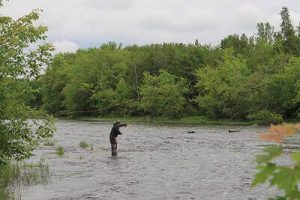
The Bottom Line
Fly fishing can be peaceful as well as exciting and challenging. It is not difficult to learn how to fly fish. In this article, we have discussed fly fishing tips to help you catch more fish on your fishing expeditions.
If you also fish for bass, this article on bass fishing tips shares some tips to help you catch more bass. You can also read walleye fishing tips, catfishing tips, and striped bass fishing tips. Additionally, if you are interested in the best fly fishing sling packs then read this review.
